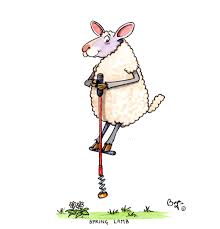Be the Pogo Stick!

Imagine that you’re 15 again. You can run effortlessly, you have no injuries, and you are just enjoying life other than the obvious ‘who the hell wants to be a teenager again’ period in your life. That 15 year old has spent time and years learning how to develop supporting muscles for impact since the time they started to crawl. From crawling there was a lot of time practicing standing, then walking, then more walking and running soon thereafter. They are constantly moving, exploring their body in space, experimenting by climbing trees, playing tag with their friends, and playing on playground equipment.
That’s functional fitness.
Once they reach the age where they have some motor control over their bodies, then we as parents immediately sign them up for sports (I won’t go diving into this right now, but specialization is not necessarily a good thing). From here they learn how to kick a ball, catch a ball, do cartwheels, flip turns in the pool, karate chop their friends, and do pirouettes. In other words they continue to develop their functional fitness while learning new skills. Generally most kids have fun with these activities. They get to meet new friends, and learn how to set goals, etc. They learn that they aren’t always going to succeed, but if they keep trying and practicing they see the reward. Real world skills.
That’s developing a human/athlete.
Then comes the time where they no longer get to play. Things get serious. You get a job, you sit in the car for hours, sit at a computer all day, and you’re stressed all the time. Those that skipped out on a lot of that developmental stuff (you can be a farmer’s kid and build all this BTW, you don’t have to be a sports junkie), and later in life they decide they want to be an athlete they are at handicap compared to some of their peers. It doesn’t mean that they can’t be great athletes, but what it means is that it’s going to take longer to develop the deeper core strength and stability needed to perform any sport. For those of you where were athletes in your previous life? Those motor skills are still there, they are just rusty and need to be reawakened, and strengthened again.
Every athlete does not want to get injured. But let’s get real, every athlete has an injury at some point in their life. It’s a fact of life, that no matter what age you are YOU WILL GET INJURED. This is the time where you spend learning how to figure out just what caused this injury (could be traumatic, could just be overuse, and compensation patterns). You learn where your weaknesses are, and where you are leaking out power and compensating and fix it. First you have to see how stiff and supportive your spine/pelvis is during a stationary position. I want you to imagine that you are a brand new Pogo stick. Super springy, stiff, and it’s easy to learn how to jump up and down on it. Now imagine that your Pogo stick is 10 years old, and the springs are shot, and every time you try to jump on it it takes more and more work. That is your adult body in a nutshell….you now can’t absorb shock and turn it into “free” energy like before. Now your body has to come up with imaginative ways to do the same movement that was so easy when you were 15.
So here is a quick test for all of you. Can you:
Lift up your knee higher than your hip easily ?
Can you lift up your knee, and stay on that other leg without falling over (take off your shoes for this, as shoes are awful with giving feedback to your nervous system)
Can you even stand on one leg for more than 30 seconds? Eyes closed?
Can you lift up a hip and hold it (your foot will only be an inch or so off the ground, right next to your other leg…so practice this with the feet close together)
When you lay on the ground (face down), can you bend your knee, and lift the leg off the ground without your lower back getting tight, or can you even get your leg off the ground at all (in reality you want to be able to lift that knee/leg at least 8+ inches).
Can you hold a side plank (the easiest version on your elbow) for more than 30 seconds?
If the answer is NO to most of the above, then chances are you really need to fix yourself (notice I said ‘self’. Unless you like to pay a lot of money for rehab). Because, guess what? Whenever you land on your foot in a running stance you need to not collapse like a cheap cardboard box. This is spine control. It also means that you’ve probably been compensating with muscles that weren’t specifically developed to be the prime movers for that action.
So here is a quick and easy fix to this problem – spend time working on it. I highly recommend Stuart McGill’s Big Three and the Long Posterior Glute Bridges as they are easy to do, don’t take a lot of time, and you will feel results within a couple of weeks. Do 2-3 rounds of each movement (10 of each specific movement), and report back to me after a month.
Let’s see if we can find that youthful springiness so that we can stay stronger throughout the rest of our life!
